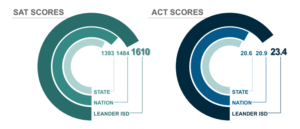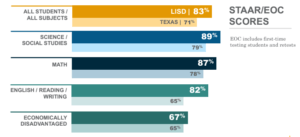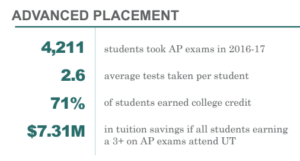By LYNETTE HAALAND, Four Points News
Leander ISD is above average in student test scores and has gained national academic attention as the district with 39,000 students continues to grow.
“One of the reasons the district is so strong is success academically,” said Superintendent Dan Troxell at the annual State of the District presentation on March 21.
SAT/ACT
Standardized tests used for college and university admissions are one measure of academic success at LISD.
Students at LISD average 1610 on the SAT compared with 1484 at the national level and 1393 at the state level.
Students average 23.4 on the ACT at LISD compared with 20.9 at the national level and 20.6 at the state level.
“We are about 200 points above the state average. That’s why a lot of our kids get provisional admission to go to universities of their choice, because we have very high performance,” Troxell said. “Same thing with the ACT. You can see we are two points higher.”
“Our kids are ready for those college entrance exams by the work they’re doing in elementary, middle and high school,” Troxell said.
National merit scholars
Across the district, there are 126 National Merit Scholars, students who qualified by their pre-SAT exam scores their junior year.
“That’s a phenomenally high number of students who are National Merit Scholars,” Troxell said.
Troxell pointed out that districtwide these scholars get heavily recruited by universities.
Looking closer at Vandegrift, there are 17 senior students who qualified as National Merit Semifinalists, representing less than 1 percent of U.S. high school seniors who scored a 221 or higher on their 2016 PSAT.
Vandegrift also has 38 senior students who qualified as National Merit Commended Scholars, which are students who placed among the top 5 percent of more than 1.6 million students for more than 22,000 high schools who entered the National Merit competition by taking the PSAT in the fall of their junior year.
STAAR
The State of Texas Assessments of Academic Readiness or STAAR testing is another measure of success.
LISD students in all subjects average 83 percent on the STAAR compared to the state average of 71 percent.
Troxell made the point that LISD students should outperform the state because we have less poverty.
LISD has a low percentage of economically disadvantaged students, 7,233 of the 39,000 total
equals some 19 percent in poverty compared to 60 percent statewide. This is a family of four making $25,000 or less annually.
“Poverty doesn’t mean you can’t learn. It just means you have a lot of things to overcome. A lot of kids in poverty have to have jobs when they are in high school, they’re taking care of families,” Troxell said.
But still LISD’s economically disadvantaged students outperform the state on average STAAR scores, 67 percent compared to 65 percent.
“I want that number to widen and grow but I am proud of the fact that our economically disadvantaged students are doing so well,” Troxell said.
Four-year graduation rates are 95 percent for economically disadvantaged students in the district compared to 97 percent district-wide.
Advanced placement
Advanced placement examinations, created by the nonprofit College Board, are tests at the college-level rigor that are given to students after they take high school courses.
There were 4,211 LISD students who took the AP exams in 2016-17, and 71 percent of the students earned college credit.
This equates to cost savings at the university level. For example, if all of those LISD students who earned a 3+ on the AP exams were to attend University of Texas, the tuition savings would be $7.31 million, Troxell said.
AP Honor Roll
LISD is recognized as an AP Honor Roll district, one of 457 districts throughout the U.S. and Canada to earn the distinction.
The College Board looks at a lot of criteria including student scores increasing every year, even with increases in student enrollment. The board also measures scores of all economic and ethnic backgrounds and checks to see if those scores are also growing.
“That’s quite an honor. It shows that the 71 percent passing rate on AP exams is being recognized nationally and internationally,” Troxell said.
Risa Ginther, resident of Avery Ranch and a leader of the Parent Teacher Student Association, is proud of what LISD has done on student involvement and diversity. “They really value diversity,” she said.
Dual credit
There are 88 dual credit courses offered tuition-free by Austin Community College where students earn high school and college credit at the same time.
In 2016-17, there were 1,296 LISD students enrolled in dual credit courses and earned an average of 8.1 credit hours per student, which is about half a semester, Troxell said. This would equate to $4.57 million in tuition savings at UT if all students passed their dual credit courses during last school year.
Troxell said that dual credit is not accepted by every university so it is helpful to start talking to the universities of interest early about this topic.
Even if it is not accepted at the university of a student’s choice, dual credit is beneficial, he added.
“It gets kids prepared for college, taking college courses while they’re in high school. It lets kids know they can do college work,” Troxell said.
Extra curricular
“Our kids perform exceedingly well. It is really an attribute of them and their families, it’s a real compliment to our coaches and sponsors,” Troxell said.
He shared the list of high achieving programs across the district including soccer, wrestling, band, robotics, volleyball, cheer and swim and dive.
Matthew Schaefer, resident of Steiner Ranch, is impressed with the many levels of success in LISD programs.
“I was impressed with all of the diverse achievements (academic, marching band, sports, robotics, etc.) across the entire district,” Schaefer said.
Troxell pointed out that LISD students stand out for the range of activities that students are passionate about.
Additionally he said that students know what they want to be when they grow up earlier and earlier.
“The district plays a large role in that as it engages and inspires students to identify what they are good at and how that may become a career choice. Teachers and counselors also help students to build their school courses toward future goals,” Schaefer said.
Rose Burkhardt, PTSA volunteer in Four Points, agrees. “It’s stands out what our district does for the student.”




